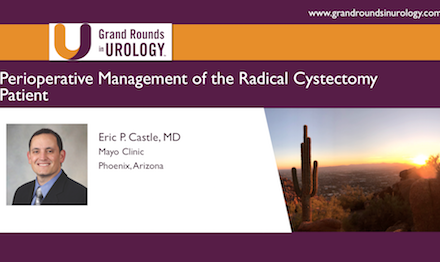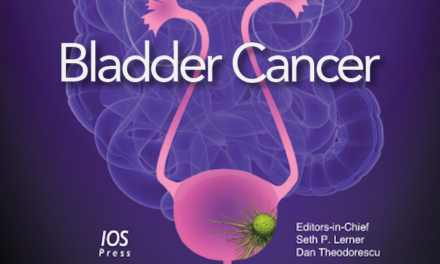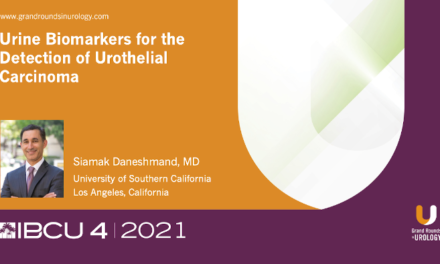Dr. Sam S. Chang presented “Diagnosis and Treatment of Non-Muscle Invasive Bladder Cancer: AUA/SUO Guidelines” at the International Bladder Cancer Update meeting on Tuesday, January 24, 2017.
Keywords: non-muscle invasive bladder cancer, BCG, biomarkers, chemotherapy, cystectomy, cystoscopy, AUA Guidelines, SUO Guidelines
How to cite: Chang, Sam S. “Diagnosis & Treatment of Non-Muscle Invasive Bladder Cancer: AUA/SUO Guidelines” January 24, 2017. Accessed Jan 2025. https://dev.grandroundsinurology.com/diagnosis-treatment-non-muscle-invasive-bladder-cancer-auasuo-guidelines
Transcript
Diagnosis and Treatment of Non-Muscle Invasive Bladder Cancer: AUA/SUO Guidelines
This is a talk that gives you I think highlights regarding the guidelines that we have for non-muscle invasive bladder cancer that was a joint product of both the AUA and the SUO, and through the talk I’m going to give you highlights of points that I think are important and that were different from the previous guidelines. So, these guidelines came out less than a year ago, were published actually approximately six months ago, and it’s an attempt to I think integrate some of the newer knowledge that we’ve gained over the time period from the previous guidelines, which was back in 2007.
The purpose of the guidelines, as with most guidelines, is an attempt to give the clinical practicing urologist a framework, an idea of how to evaluate patients, how to treat patients, and how to follow up patients. And this was an attempt for the first time to move away from our index patients, which some of the guidelines have used, and take into account a risk stratification screen, and that is an attempt to basically understand that individual patients represent a very heterogeneous group, and to evaluate each one at a different point in time helps determine their best treatment. And so, we went through a review of I guess 150 different studies focused on randomized clinical trials, and focused on the data that hopefully was of the highest quality, and we were assisted by AHRQ, and the focus was on non-muscle invasive bladder cancer, focusing specifically on TA disease, CIS, and T1 disease. The focus as well was taking into account the most recent grading system, taking into account low-grade disease, papilloma, as well as non-muscle invasive low-grade and high-grade disease.
In understanding the importance of bladder cancer treatment there’s obviously the issue of recurrence as well as looking at prognosis and the issue regarding progression. And so, this is an attempt in this guideline to risk stratify these patients as opposed to the one size fits all. And what we actually did for the first time was come up with a stratification table. Now, this table looked at and identified in buckets low-risk patients, intermediate-risk patients, and high-risk patients. And as one would assume the low-risk bucket clearly low risk. These are small tumors, individual or PUNLMP tumors. The high-risk tumors were those that have higher pathologic concerns, but also actually for the first time we included response to therapy, and I’ll talk a little bit about that as we go through.
The most difficult group was the intermediate-risk group. I mean honestly some of the intermediate-risk group patients act more like low risk, for instance a solitary low-grade larger tumor probably acts more like a low-risk tumor as opposed to a high-risk tumor. But this was an attempt to give some stratification in terms of how these patients have in terms of recurrence as well as progression.
In looking at a diagnosis we went through diagnosis, evaluation, treatment, and follow up, and as we went through the data one thing that was very clear was the lack of standards in terms of describing what is done at the time of TURBT. So, for the first time we actually laid out that in documentation there was debate whether or not we should use maps, verbalization, a combination of both, but an idea of basically giving an idea for that practicing clinician, and anybody else who may be treating that patient, what a tumor looks like, where it’s located, how many tumors there were, and the actual quality and nature of the tumor itself. And part of that was we understood that many times complete visual resection is the goal for the clinician, and that we also understand that many times we are missing tumors, we are not going a good enough job in terms of evaluating them upfront, and actually up to 45% of patients with tumors seen at follow up may be tumors that were missed at the initial TURBT.
Some basic clinical principles that aren’t much different, the importance of performing an upper urinary tract study, as well as the fact that if you have that tricky patient with what appears to be a normal cystoscopy with abnormal urine study, specifically an abnormal cytology, a clinician should consider certain things to do; one would include biopsies of the prostatic urethra, as well as upper tract evaluation and imaging, as well as the use of enhanced cystoscopic techniques, and/or random bladder biopsies. And so, this is actually a new addition to the guidelines from 2007 as well.
Risk stratification; what we did was actually take a combination of the previously well-done models put out by EORTC and CUETO looking at okay these are patients who are more likely to recur, who are more likely to progress, or both. And there were specific factors that came into play for them, including tumor size, tumor focality, the grade, stage, recurrence pattern, and the number of tumors. Well, to this risk panel and stratification we added certain histopathologic variance, specifically lymphovascular invasion, the presence of prostatic urethral involvement, variant histology, and actually poor response to BCG or other intravesical therapy. So, in our risk table we take into account the fact how patients actually responded to a previous treatment, in other words, a patient that came back with a smaller tumor if they’d had previous treatment already they’re put into a higher risk category as opposed to someone who came in de novo. And so, this was actually a big, we think, a big leap forward in terms of determining how patients are likely to do. And we’ll go through the algorithm at the end of this talk.
Again, a new addition was actually the variant histology recognition. These variant histologies have been around forever, and going back and looking at pathology specimens from years ago these are not new pathologies, but these are actually a recognition of pathologic patterns that bring about actually significant concern. Some of these include micropapillary, neuroendocrine, sarcomatoid, plasmacytoid. Really those types of pathologies are one where we’ve actually recommended that an experienced GU pathologist should review this. Now, this brought about some concerns about how do you describe or define an experienced GU pathologist? We left it in this way because not everyone can send a pathology slide to Mayo, to Johns Hopkins, to wherever for a secondary review, but it was an attempt to understand that if there’s concern that this variant histology exists we need another set of eyes that looks at a lot of these to help determine whether or not this is actually happening because due to the high rate of upstaging currently with this disease process we say upfront that we should actually initially consider radical cystectomy, which is a significant leap forward compared to the other bladder cancer types within the guidelines.
Biomarkers; I think Dr. Black is going to speak about biomarkers and an update regarding this, but what we found was that there are a lot of biomarkers out there but perhaps not as good as we would like them, and we say that upfront that they should not replace cystoscopy. This is a partial list of the biomarkers that are out there. They’re helpful in certain instances but they are not good enough in any way to replace cystoscopy. And specifically, the use of cytology we actually brought into account and for low-risk cancer in a normal cystoscopy, and we say that actually cytology should not be used as a normal routine kneejerk biomarker, and part of that is the data that clearly shows that the use of cytology is not only insensitive but can also have areas of concern and are unlikely to be helpful in these patients with a low risk of progression. Now, for patients that actually have higher risk disease, CIS, who have been treated with BCG, we do think that certainly the biomarkers may be helpful to help determine how patients are likely doing or responding to therapy.
A second point that has been reemphasized by these guidelines were the importance of a repeat resection or a repeat TURBT. Upfront we say that if there’s any question that there’s an incomplete initial resection then further resection should be done. A change here that I’ve outlined in red is for those patients with T1 disease. In the previous guidelines we talked about if there is no muscle present that a T1 patient or that pathology should undergo a repeat resection. This has actually been modified or strengthened to basically say if there is any patient with high-grade T1 disease that a repeat TURBT should be performed if there is any thought to go ahead and try to save this patient’s bladder, and not proceed to cystectomy. So, this is a real change. Part of that is understanding along those lines that intravesical therapy tends to be helpful with certain disease parameters as opposed to others, and we understand that for this group of patients we are not as strongly an advocate in terms of giving everyone perioperative chemotherapy, but an understanding that it is an option.
In a low-risk patient we say clearly they should not administer actually perioperative chemotherapy. For intermediate and higher risk patients intravesical immunotherapy or chemotherapy is reasonable for an intermediate risk, but for the high-risk patient we do recommend BCG as the treatment of choice, and specifically we actually modify a little bit in terms of recommendations regarding BCG. There’s no particular strain that we’ve recommended in the guidelines. We don’t talk about a particular strength, and right now there is not enough data to say a combination of immunotherapy with chemotherapy is any way better.
This is a bit of a modification from the SWOG outline protocol regarding BCG maintenance therapy, and for intermediate risk patients we say that upfront that our recommendation is to consider maintenance for at least a year, whereas for the high-risk patient we do recommend continued up to three years, taking into account the impact of possible side effects associated with it. Now, part of this was based upon a European trial which was not powered to overall outcomes, actually was looking at complications and side effects, and what was basically found was that, let me go back, was that for patients with intermediate risk disease if you had a combination of either one-third strength or one year, one-third strength or three years there was really no difference in terms of outcomes or side effects, but there seemed to be an advantage for high-risk patients for a full dose and for three years of therapy, for the full three years, and as a result, for the high-risk patients we do recommend that. For the intermediate-risk patient we say at least a year and if it’s well tolerated continue to attempt to try to complete the full three years.
Relapse regimen; still importantly for those patients that have high-grade T1 disease after single dose of intravesical BCG if there is still disease present the recommendation is still to offer radical cystectomy. In addition, we’ve made it clear that those patients that have BCG and it’s not well tolerated and/or unfit for cystectomy we need to consider after two induction courses of BCG another therapy. Any more BCG after that has really little, if any, response and probably if anything a negative response. And so, we recommend that if they’re not fit for cystectomy or unwilling to consider at least a clinical trial, and/or a different type of intravesical regimen. That intravesical-specific regimen was not outlined specifically. Options are given within the actual document.
Cystectomy; this was actually a statement that we made upfront, which we didn’t previously in the guidelines, is for patients with actually low-risk disease, lower intermediate-risk disease, an attempt should be made to have some type of bladder sparing treatment done. Large-volume tumors can be treated adequately with resection and intravesical therapy, and upfront this should be attempted before moving to cystectomy. In addition, for high-grade disease, and those that have varying histologies initial radical cystectomy is an option. So, understanding the importance of those patients with perhaps a higher volume T1 disease or multiple locations, and/or those with varying histologies upfront cystectomy is definitely something that can be considered and should be offered. And in those patients who have continued disease and/or recurrence soon after their intravesical immunotherapy the radical cystectomy should be offered.
We have a separate section for the first time to talk about enhanced cystoscopy techniques, understanding that not everyone has these available. We basically say that if available we should offer blue-light cystoscopy to increase detection and decrease recurrence rates. In addition, they may consider the use of NBI for those patients also to increase detection and to decrease recurrence rates.
In 2007, we had nothing about follow-up. Our one statement was that these patients should undergo follow up and routine surveillance. So, an attempt to try to address that need unfortunately there was no evidence that says this is the best policy or this is the best practice that we should advocate. So, these are our recommendations; for low-risk patients at their first surveillance cystoscopy if that is negative the next surveillance should be done six to nine months later. So, the habit of every three months for the first couple of years is something that we’ve actually pushed off, and to try to decrease the morbidity and also decrease the rigor for these low-risk patients. In an asymptomatic patient with a history of low-risk disease routine upper tract surveillance, so the CT scan or the retrograde pyelograms, or the yearly renal ultrasounds are actually not necessary and should not be performed. And for low-grade disease if there’s anything smaller, for the first time we did support the use of in-office fulguration for those patients who have previous pathologically documented low-risk disease.
For those patients with intermediate-risk disease we actually accelerated or made more rigorous the surveillance protocol, and allowed some flexibility of every 3 to 6 months and then every 6 to 12 months. But for high-risk patients we did maintain the rigor of every three to four months for the first couple of years to do evaluation cystoscopy. And for these higher risk or intermediate risk patients that upper tract surveillance was something that should be considered, and one- to two-year intervals we thought was reasonable.
We have a whole section, as do most guidelines, regarding ongoing research, and this is just a partial list of what’s going on with non-muscle invasive disease. And this is our algorithm. So, this is a complicated but one-page, that was the goal of both the AUA and the SUO was to try to get on one page an outline of the algorithm. And this I can tell you at our residents’ clinic, at our VA, this is the one page that the residents have. This is the one page my partners have on the wall to basically help go over kind of all right, I’ve got this patient, what do we do? Now, the nice thing about this if we look at low risk is we’ve got the consideration of post-operative chemotherapy. If there’s a complete response surveillance, if there’s recurrence or if there’s partial no response this patient actually gets moved into the intermediate risk patient. He’s not always a low-risk patient. It takes into account response and how they do. And how you’ve got the intermediate-risk group and the high-risk group, and you’ve got these dotted lines that tell you hey you can consider upfront cystectomy for the high-risk patients. For those patients who actually failed chemotherapy, failed BCG they move straight to cystectomy. And so, you’ve got this basically variation where patients can actually change risk groups based upon their recurrence and their progression rates, and also take into account variability and flexibility.
I’ve gone through this multiple times with different types of scenarios and so far it seems to be okay. If anybody finds any issues or concerns this is something that we’ll continue to update and evaluate.
What’s next? Well, actually this coming May for the first time actually multiple organizations are going to come together for the muscle invasive guidelines. So, there has been a memorandum of understanding and an agreement between the AUA, ASTRO, ASCO, and the SUO, and there’s a guidelines committee specifically for muscle invasive bladder cancer. And some of the panel members include actually some, actually some of the folks here as well, and this takes into account a multidisciplinary group of urologists, of medical oncologists, of radiation oncologists, of patient advocates, all in an attempt to actually provide guidelines for muscle invasive disease. And this is the first time that actually like I said all of the different organizations that actually treat muscle invasive bladder cancer have come together, and that presentation will be actually done by the vice chair, Jeff Holzbeierlein, and that will be presented actually at the AUA meeting in Boston.
Some concepts, a brief preview, there will be some focus on neoadjuvant chemotherapy taking into account the important data that actually Dr. Crawford mentioned that still has not, or is starting to gain traction but an attempt for the first time to actually put that into guidelines. Actually, the role of multimodality preserving, bladder preserving therapy and the importance of surveillance and how that should be done for muscle invasive disease for patients who actually have had their bladders removed or have had some type of bladder preserving modality. So, that should be, so far it’s on timeline and should be done, and definitely should be presented by the AUA this spring.
This is the last slide, this is actually the guideline’s panel from the AUA and SUO guidelines. The vast majority of work was clearly done by all of the panel members here who completed those guidelines in actually less than a year, which is actually the quickest that AUA has ever done a guideline. So, I thank you for your attention.
ABOUT THE AUTHOR
Dr. Chang is the Patricia and Rodes Hart Endowed Professor of Urologic Surgery and Oncology and the Oncology Fellowship Director and Vice Chair of Urologic Surgery at Vanderbilt University Medical Center in Nashville, Tennessee. He is a graduate of Princeton University and Vanderbilt University Medical School (where he earned a full 4-year Justin Potter Scholarship) and he completed his Uro-Oncology Fellowship as Chief Fellow at Memorial Sloan-Kettering Cancer Center. He also completed his MBA at Vanderbilt’s Owen School of Business.
Since his return to Nashville, Dr. Chang has focused on urologic oncology and education and has led efforts in the integration of evidence-based medicine in clinical pathways, enhanced national guidelines formulation, and improved urologic cancer staging. He has orchestrated the initiation and expansion of multiple cancer-related treatment protocols at Vanderbilt and elsewhere.
Dr. Chang has served as the Chairman of the SUO Panel on Hormone Refractory Prostate Cancer, the Chair of the American Joint Committee on Cancer GU Staging Task Force, the Chair of the AUA/SUO Guidelines on Noninvasive Bladder Cancer, the Facilitator and Vice-Chair of the Renal Malignancy Follow-Up AUA Guidelines Panel, the Chair of the AUA/ASCO/ASTRO/SUO Guidelines Panel on Non-Metastatic Invasive Bladder Cancer, and the Chairman of the AUA Prostate Cancer Core Curriculum Committee. He is a former member of the NCCN Kidney Cancer Panel. In addition, he was an AUA-EAU Academic Exchange Fellow.
Dr. Chang has authored more than 250 original publications, multiple book chapters and edited several textbooks. For his academic efforts, he received the SUO’s first-ever Distinguished Service Award, a CaP CURE Young Investigator Award, and has been named multiple times as a Journal of Urology’s Best Reviewer.
Dr. Chang was named as the 2011 recipient of the American Urologic Association Gold Cystoscope Award and completed a term as a nominated Fellow of the Nashville Health Care Council in 2016.





